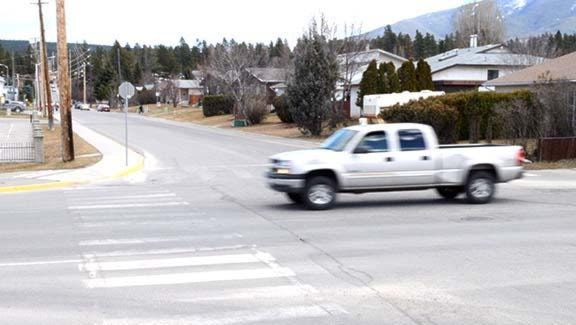There doesn’t seem to be a simple solution to making the crosswalk at Victoria Avenue and 3rd Street South safer.
The intersection presents hazards because of the merging four-lane traffic pattern at that location. As traffic heads north on Victoria, the single lane diverges into two lanes before the intersection. Traffic in the other direction is two lanes that converge heading towards Gold Creek.
At council on March 9, CAO Wayne Staudt said the RCMP is looking at reports of speeding on Victoria, which is one of the issues reported by the public.
The intersection formerly had a crosswalk sign, but that was removed when Muriel Baxter school was closed.
However, the crosswalk doesn’t meet the minimum distance from a signalized intersection under province’s pedestrian guidelines — since there is a traffic light at Victoria and 2nd Street 190 metres away.
“It doesn’t quite meet the Pedestrian Crosswalk Control Manual for British Columbia, but you know it’s close,” Staudt said.
The manual requires the minimum distance to be 200 metres from a signalized intersection, with a preferred distance of 400 metres.
“The other thing is it’s not in our five year financial plan,” he said.
City staff estimated that installing overhead pedestrian activated signals would cost $75,000 — and that’s if it is installed by Public Works crews.
Staudt said with that type of light system, there may also be congestion on Victoria Avenue and 2nd Street.
“Because if that light is holding up traffic on the other side of 3rd and the light is changing down by 2nd, you may have some additional traffic concerns,” Staudt said. He added that the issues are similar to those found when the city looked at a crosswalk near the high school.
Staudt said it’s up to council how to proceed, but city staff was recommending that council not proceed with the crosswalk.
Acting Mayor Wesly Graham said council should look at whether the city needs crosswalks at every corner.
“If we aren’t going to make the crosswalks safe, then maybe we should just remove it — black paint it over, that way it’s gone — if we can’t make it safe for pedestrians to cross,” Graham said. “Has that been considered?”
Eric Sharpe, director of Engineering and Development Services, said that while they can get rid of the painted lines on the road, it will still exist as a crosswalk.
“Under the B.C. guide, it’s still a crosswalk whether it’s marked or now,” Sharpe said. “It’s still up to vehicles to yield to pedestrians at crosswalks. So regardless of whether it’s marked or not, it’s still, corner to corner, legally a crosswalk.”
He confirmed that every intersection from corner to corner is legally a crosswalk.
Coun. Danielle Cardozo asked whether there are alternatives to the flashing overhead crosswalk.
“We know it’s a highly used crosswalk, we know from the report that there are visibility and sight issues — it’s a dangerous area,” Cardozo said. “So is there something we can do to make it more safe for the children/adults/seniors who use it on the regular?”
Sharpe said it is a challenging crosswalk, especially due to the speed.
“Victoria is one of our main arterioles where people try to make up time,” Sharpe said. “This particular one, because it is four lanes people have a large space to cross in a relatively short period of time — they normally say 15 to 20 seconds is about the time it takes to get across. People are jockeying for position as they’re going up the hill and as they’re going down the hill they’re splitting out into four lanes. It’s a spot that is an atypical crosswalk for sure. Having lights there may very well make it a safer crosswalk.”
Council referred the report to the Cranbrook in Motion committee for another look. Staudt noted that there council could also get input from the RCMP and ICBC.
